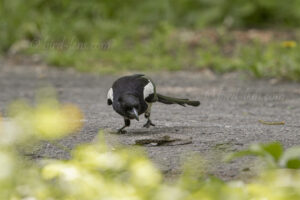 In the wilderness, nature stages captivating dramas that unfold in completely unexpected ways. Today the scene is in Bucharest. Unfortunately, Stirbey Park is filled with horrible, loud gypsy music. It’s a shame, nowhere is you safe from it. We check out different places. But nothing to see. In the heart of the park, which features lush old trees, we see 2 Eurasian Magpies (Pica pica), adorned with their shiny black plumage and iridescent shades of blue and green, in their daily search for food.
In the wilderness, nature stages captivating dramas that unfold in completely unexpected ways. Today the scene is in Bucharest. Unfortunately, Stirbey Park is filled with horrible, loud gypsy music. It’s a shame, nowhere is you safe from it. We check out different places. But nothing to see. In the heart of the park, which features lush old trees, we see 2 Eurasian Magpies (Pica pica), adorned with their shiny black plumage and iridescent shades of blue and green, in their daily search for food.
On this special day, the magpie’s fate is kind. She sees a sinuous figure slithering out of the undergrowth – a snake. It is a Dice Snake (Natrix tessellata) whose slender body moves with stealthy grace. Unimpressed by the snake’s considerable size, the Eurasian Magpie, recognizes the opportunity for a sumptuous meal.
With lightning-fast reflexes and a tactical mind, the Eurasian Magpie launches its attack. She swoops down with claws outstretched, grabs the snake by the middle of its length and immobilizes it with a precise bite. The surprised snake twists and turns in a desperate attempt to free itself from the Eurasian Magpie’s clutches, but the bird holds the Dice Snake firmly in place.
In a breathtaking display of her mastery of the air, the Eurasian Magpie soars some meters above ground, her prey dangling below like a trophy of her triumph. Despite the snake’s valiant struggles, the Eurasian Magpie maintains its grip and evades the snake’s attempts to retaliate with bites.
While the Eurasian Magpie immobilizes its prey, it flies to a secluded place that is hidden from our sight. The real hit is that I get to photograph a collision between a Dice Snake and a Eurasian Magpie that is both hungry and curiously wary.
If you want to visit Stirbey Park, you drive from the capital’s airport towards Bucharest and then onto the ring road. Then head east to Stirbey Park. An old English landscape park welcomes us. Wow, that’s really great. In the middle there is a stately villa. A parking lot gives an idea of the former communist dreariness. It is located directly behind a dilapidated industrial landscape. But at least there are parking spaces and there are only a few cars there. The first bird can be seen here: a male Black Redstart (Phoenicurus ochruros).
The park showcases some of the amazingly prolific wildlife of continental Europe. But the old beech and oak trees are also something special. Soon we will not only see Green Woodpeckers (Picus viridis), Eurasian Jays (Garrulus glandarius), Eurasian Jackdaw (Corvus monedula), Eurasian Nuthatch (Sitta europaea) and a Common Redstart (Phoenicurus phoenicurus). Cristian shows me the nesting hole of a Lesser Spotted Woodpecker (Dendrocopos minor), which is made in a branch like typical for this species. Unfortunately the owner of the hole doesn’t come out. A Syrian Woodpecker (Dendrocopos syriacus) can also be heard with its typical call. The nest of the one breeding here Black Woodpecker (Dryocopus martius) unfortunately, Cristian hasn’t found the yet. Stirbey Park is a real recommendation for a trip when you are in Bucharest.
In order to meet the growing demand for top images of the rarer species of Palaearctic Bird-lens.com has specifically made trips to remote places. Additionally every chance is used, if a rare bird is around the homeground. This to do everything to ensure excellent photos of the Birds of the Western Palearctic . The yield of pictures also of rare Western Palaearctic birds is very good. There are other nice images of birds, that you will find behind the tab “Picture Shop“. Just give a notice if you need a picture of a bird which is not online.